ASUS N10JC: the Netbook Goes Corporate
by Jarred Walton on December 24, 2008 4:00 AM EST- Posted in
- Laptops
Battery Life and Power
We will start with measurements of power use with the laptop plugged into the wall. Keep in mind that some power saving features are not fully functional unless you are running on battery power, but it's still interesting to compare power requirements with other laptops under similar conditions.
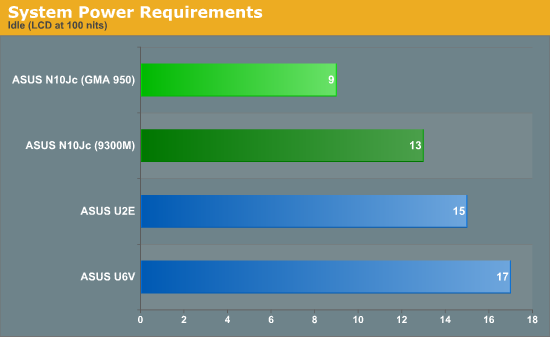
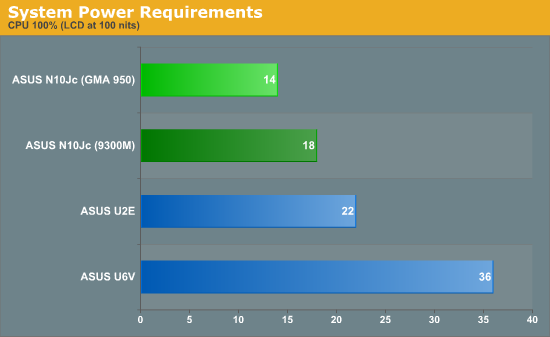
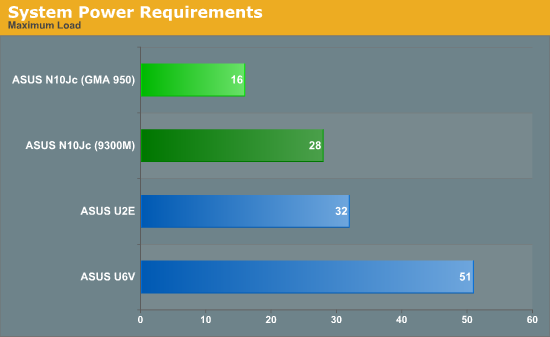
We see a significant drop in power requirements relative to the ultra low voltage Core 2 Duo U9500, especially when we disabled the 9300M. In best case scenarios, we should see almost twice the battery life for the same size battery capacity, and at worst battery life using the GMA 950 should still be 50% better. Even with the discrete graphics enabled, battery life should still be better than the U2E by a decent amount.
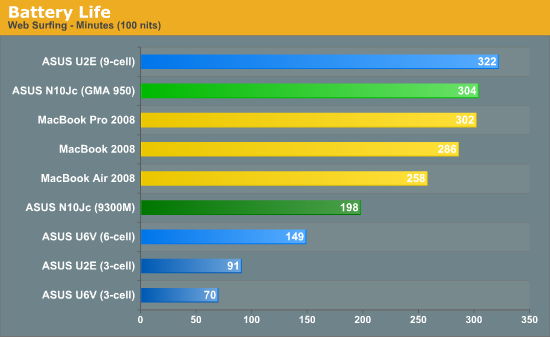
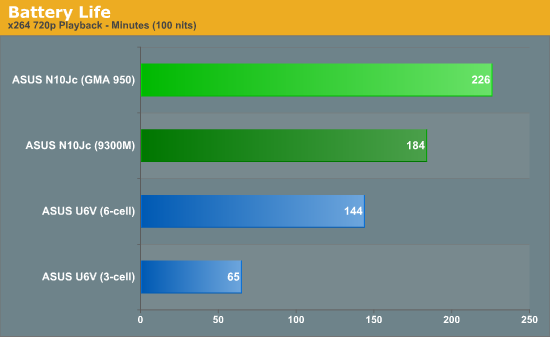

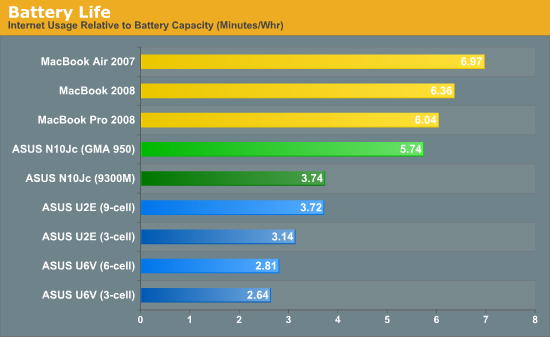
We don't have results for all of the test systems under each test scenario, but probably the most interesting performance metric is going to be battery life while surfing the web. There we see that the N10JC just manages to edge out the new Apple MacBooks, nearly matching the U2E with a 9-cell battery. That's great for Windows performance, but unfortunately you need to keep two things in mind. First, the Apple MacBook line is still offering better battery life relative to battery capacity. Second, the same MacBooks all offer quite a bit more performance -- in most cases they're at least twice as fast as the N10JC. That's the bad news; the good news? The ASUS N10JC still costs half as much as the cheapest MacBook, which definitely works in its favor.
One other item we have to address is the video decoding performance. x264 playback totally failed to stay in sync when we tried to watch a movie using just the CPU. We still ran the 720p battery tests, but if you want to watch such content you will need to enable the 9300M. We used Media Player Classic Home Theater (WMP-HC), following this guide, and didn't experience any problems. CPU usage dropped from 80%+ with noticeably delayed video to under 20% with no discernible synchronization problems.
We should also mention that system temperatures and noise levels on the N10JC are great. Temperatures never got above 32°C during testing, and the fan rarely kicked up to higher RPMs except during extended stress testing or gaming. We could not measure noise levels above the threshold of our SPL meter (30 dB).










45 Comments
View All Comments
Penti - Wednesday, December 24, 2008 - link
That's mostly directed towards iFX and I do agree that they don't get much rebates on hardware (probably a lot more on software anyway which is a bigger cost then the hardware itself many times even for desktops).My point however is that you aren't reviewing the business version, not that it differs any more in hardware then I mentioned earlier in another post and you mentioned now but rather the important fact that it contains a VB OEM license as you can't include a XP H license in your volume license agreement. That's an important difference and you don't really test it for that scenario any way.
OEM's aren't much more then retailers themselves, i.e. they can't charge the costumer less then what the ODM or Taiwanese-based contract manufacturers charge them. There really isn't much for system builders to do with laptops more then order them. It's usually as you have experienced some other company that actually put the companies images of the OS/software on them. I guess there's some potential to save there if those who act as the system builders of the OEM-computers can get cheaper OEM licenses for that costumer and orders without licenses from Asus. A OEM license is always needed though. But a XP H OEM licenses is useless for them.
iFX - Wednesday, December 24, 2008 - link
Yes, they do. I have worked in IT procurement for large, Fortune 500 companies, I speak from experience.icrf - Wednesday, December 24, 2008 - link
Interesting addition to the netbook lot, but I'd still rather have a Samsung NC10. The discrete GPU is nice for video decoding, but if the display can't show 720p, I'm not sure what the benefit of being able to decode it is. Give me a 10" 1280x800 screen and we'll talk. Otherwise, the NC10 still has better battery life.skaaman - Sunday, December 28, 2008 - link
Totally agree. I picked one up for my better half for Christmas for $499.00. Notebook Review has an excellent write up on it. The display is beautiful (same as the ASUS I believe) and easily get 7-8 hours battery life. I accidentally stumbled on the touch pad gesturing support and it works very well.I loaded the two simple games she plays and they run fine (simple games.) While a lot of time on this board is dedicated to considering how far we can stretch a system, it would seen that this and most Netbooks would more than satisfy about 90% of the consumer market. I mean really, how many systems out there are used for nothing but Internet access, email and word processing.
Also, I think we have become spoiled with cheap memory prices. 1GB for running basic apps on XP Home should be plenty for anyone. Yes if you beed to run 10 apps or want to overclock then you want as much memory as you can get. But again, 1GB will prove more than adequate for the average user.
l00tz - Wednesday, December 24, 2008 - link
Ahhh but you have hdmi out for 1080p goodness. The n10 works with and external bluray drive and powerdvd8 as welldrfelip - Wednesday, December 24, 2008 - link
A user at Notebook Review forums claims to get quite good gaming performance by overclocking the Atom to 2.1 GHz, so the CPU seems to be the bottleneck.gipper - Wednesday, December 24, 2008 - link
I have the 1000H, and I love it. However, we really need 1280x800 screens in 12" sizes. Several corporate apps like the Citrix client all but requires 1024x768 minimum resolution to run without problems.I want the 1000H in a 12" size, NOTHING changed (except maybe and even larger battery than the already ridiculously good battery it has) except for the screen. That is the perfect notebook.
strikeback03 - Wednesday, December 24, 2008 - link
The table says 2x2048MB, but the test says 1GB.I was not aware that LED backlights contained Mercury, is there a version of the computer that uses a conventional backlight for that sticker to be on there?
JarredWalton - Wednesday, December 24, 2008 - link
ASUS told me that the sticker was only on early hardware and that it's just a mistake. Good eye - I forgot to mention this, but ASUS specifically told me about the sticker when I asked if it was really an LED-lit LCD. :)JarredWalton - Wednesday, December 24, 2008 - link
Oh, and the 2x2048MB was a missed copy/paste (or reuse of a table). It's fixed now.